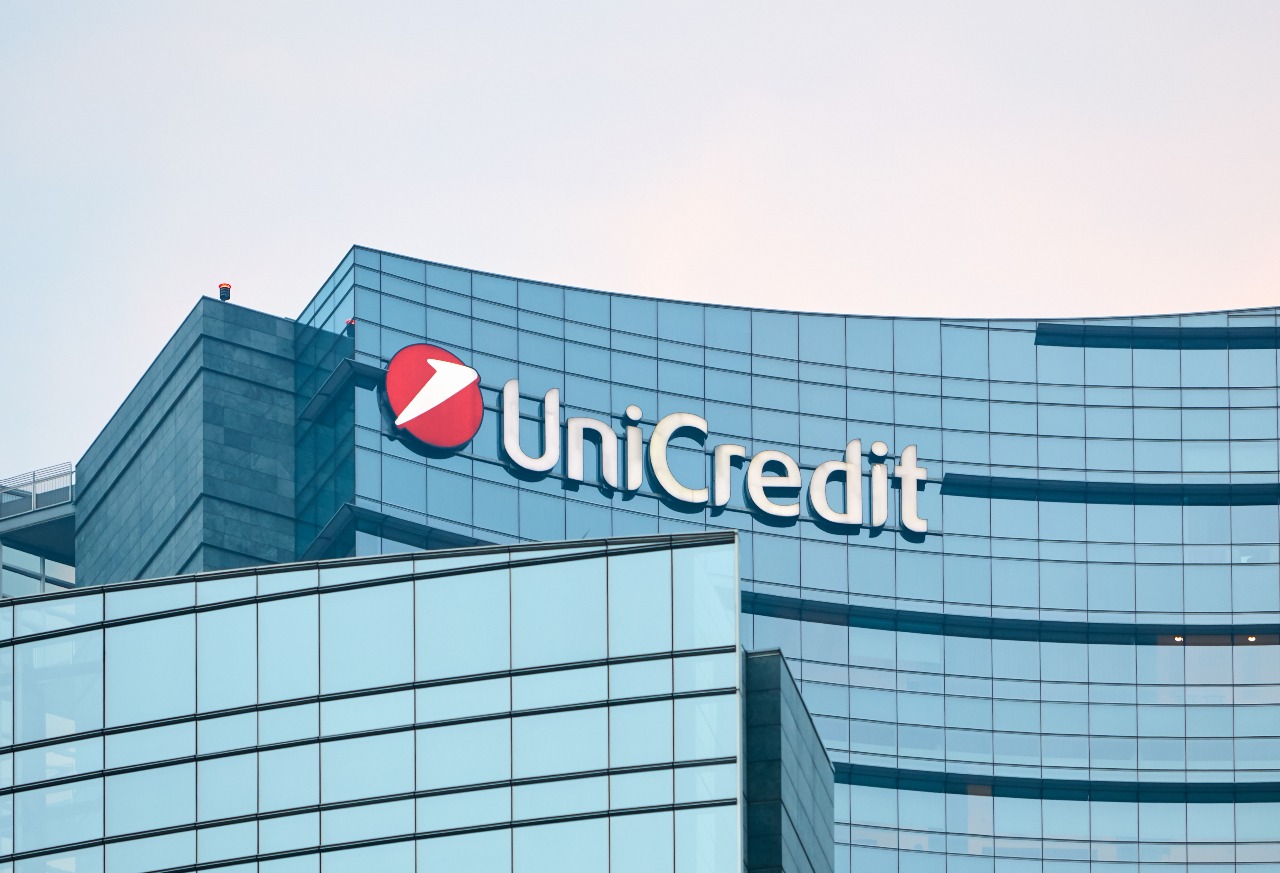
Having revolutionised banking before 2020, digitalisation has been given a colossal boost by the pandemic. From customer payments to internal communications, institutions from Lisbon to Moscow are rushing to embrace new technology. But what does this sort of transformation actually look like in the field – and more to the point, how does it get done?
Andrea Valentino talks to Finja Carolin Kütz, the group chief transformation officer at UniCredit, about what the Italian bank has cooking and why getting expertise from outsiders is vital to success.
The year 2020 was one of digitalisation. And why not? With lockdowns and social distancing making physical contact impossible – if not actually illegal – whole industries have rolled up their sleeves and adopted an alien vocabulary. Zoom. Agile. Cloud. If you can imagine it, there’s probably a start-up offering it, from virtual pub quizzes to happy hours with colleagues thousands of miles away. If nothing else, this is reflected in the numbers.
According to work by BDO Global, for example, 51% of internet users are watching more online shows than they were before the pandemic. Netflix alone saw 16 million new sign-ups in the first quarter of 2020.
And where digitalisation goes, jobs often follow. According to one study, the rise of digital economies could create six million jobs worldwide between 2016 and 2025 – and that’s in the logistics and electricity industries alone.
Though it’s probably less sexy than Netflix and chill, similar growth can also be seen in the banking sector. Once again, even a cursory look at the statistics is revealing. By November 2020, for instance, European banks had seen a 72% rise in the use of their fintech apps since the start of the pandemic.
These changes are particularly clear among young people. Nearly 30% of under 35s believe that the coronavirus has fundamentally changed how they look after their finances, compared with just 17% of older people.
Naturally, all this is shadowed by work at specific banks. In Paris, bosses at Societe Generale recently launched a vast campaign of digital transformation, complete with a €150m start-up budget. At HSBC, meanwhile, new technology is touching everything from payments to liquidity.
Not that the path to banking digitalisation is straightforward. From legal challenges to the constant threat of security breaches, even the largest banks have to take care not to go too far, too fast. Yet with the right expertise, financial institutions have colossal opportunities, whether in terms of helping customers, making life easier for staff, or simply saving money. That, at any rate, is the strategy being pursued by UniCredit.
Even more than some of its competitors in the field, the Italian institution is embracing digitalisation comprehensively. Scooping up economists and data scientists, investors and government officials, its work heralds a digital world that touches every aspect of the banking process – with lessons for banks far beyond its Milan headquarters.
Tech a seat
Over two decades ago, when she first entered the world of banking, Finja Carolin Kütz remembers just how personal so much of it felt. On the financial desk at Oliver Wyman, a New York management consulting firm, she recalls seeing traditional trading floors, and how so much of the buying and selling was done through phone calls and hand signals. It was “like you were in some old Wall Street movies”, recalls Kütz, since 2018 the group chief transformation officer at UniCredit (she’s also UniCredit’s deputy COO).
More recently, of course, everything is different, especially in trading. “Nowadays,” she explains, “complex algorithms are driving significant trading volumes, post-trade processes are largely automated and simpler products have been mostly moved on to digital platforms that we use to engage with and support our customers.” Expert advisors, for their part, normally only step in when the transactions are too complicated for the computers to handle.
All the same, if floor trading threw off its shabby Gordon Gekko reputation years ago, retail banking has been slower to adapt. This may seem surprising given how much attention it’s recently enjoyed, but look at the statistics and this inertia begins to make sense.
First, there’s the question of what customers are comfortable with. Even today, 82% of people say they visit a brick-and-mortar bank at least once every six months, and 65% feel reassured knowing their bank manager is in a real office on the high street. With those kinds of numbers, convincing customers to do all their banking online has traditionally been tough.
An arguably even larger challenge, especially within the European Union, is regulation. Until PSD2, an EU regulation promulgated in 2018, banks weren’t under any obligation to share customer data with third parties, even if the customer themselves demanded it. It goes without saying that giving all that power to established banks stymied innovation, just as an entire fintech ecosystem was sweeping the US. Yet as the arrival of PSD2 implies, things are changing.

As Kütz puts it: “It means open banking and a new level of competition based on higher transparency.” She has a point. Dozens of European banks are now embracing the digital revolution, from BBVA in Bilbao to Commerzbank in Frankfurt. It’s unsurprising, then, that by the end of 2019, investments in European fintech companies had reached a mammoth $5.1bn.
Of course, all this would be impossible if customers weren’t willing to take the plunge. But here, too, things are changing. Prodded along by better technology – making it simple to check an account or make a payment – European consumers finally seem keen to embrace new technology.
A case in point comes from UniCredit, which is partnering with a fintech firm called Meniga. “Thanks to this collaboration,” explains Kütz, “we can offer our customers, as an integrated part of their mobile banking app, the ability to aggregate banking accounts from all their banks and have the transparency on their financial situation in one place.”
A good start. But Kütz and her colleagues at UniCredit clearly have bigger plans than just sponsoring yet another fintech enterprise. Rather, they seem determined to totally transform their operations across their business.
Milan with a plan
UniCredit’s headquarters do not resemble the cityscape they dominate. A glass and steel
cheeseboard of a building, flanked by an even taller spire, it looms incongruously over the grumbling trams and 19th-century palaces of central Milan. Architecturally, the tallest building in Italy has received its fair share of criticism – one Italian writer compared it to Stalinist Moscow.
Beyond the aesthetics of the place, though, the sheer newness of the UniCredit tower is an excellent symbol of just how enthusiastically the bank is embracing technological change. And unlike some of its competitors, it’s doing more than drilling down on specific areas like payments or blockchain. Led by Kütz, UniCredit’s Transformation and Innovation Advisory Board instead promises to build a “bank of tomorrow” that offers deep product knowledge as well as a range of advisory services.
Read about the calibre of contributors to the advisory board and you get the impression that Kütz and her team are serious. There’s Dr Carlo Ratti, an architect and MIT professor specialising in how digital technology could change how people live in cities. There’s also Theresa Payton, ex-chief information officer at the White House, and Eileen Burbidge, a fintech envoy at Her Majesty’s Treasury. In other words, says Kütz, it’s important to gain insights from “outstanding professionals” even if they don’t have a background in finance.
To explain what she means, she describes the role of Carlo Ratti, the architect and academic. “He can provide great insights on how our branches should evolve, and how we could best add value to the communities we are in.” She has similar praise for Katia Walsh, Vodafone’s former chief global data and AI officer, who Kütz notes has deep expertise using data to improve the customer experience.
How is all this expertise changing UniCredit on the ground? One of the bank’s most interesting projects is its partnership with FinDynamic. Bringing together customers and suppliers, this Italian firm encourages them to collaborate. If customers are willing to pay an invoice in advance, they can benefit from a discount on the invoice amount.
The most organised and proactive suppliers can even receive special plaudits from Bureau Veritas, a major inspection and certification service. No wonder UniCredit’s ‘Dynamic Discounting’ service recently won prizes from both the Italian Banking Association and the country’s president. At the same time, the bank’s partnership with Meniga is going from strength to strength. Among other things, UniCredit plans to roll out a feature letting users explore their carbon footprint.
This focus on the planet encompasses other aspects of UniCredit’s digital overhaul too. In fact, one of the group’s most ambitious initiatives is its paperless programme. Apart from aiming to digitalise all documents that flow between the bank and customers, Kütz eventually hopes to “transform the group’s banking operating model into a fully digital format.”
In practice, that means enabling sales and services digitally – think mobile apps or websites – and generally encouraging remote communication from the customer service desk all the way to accounts.
Obviously, these changes will hopefully save UniCredit time and money, but Kütz also expects that they’ll help the environment. As she notes, the paperless scheme has helped her employer save over 100 million sheets of paper in 2020 alone – the equivalent of around 12,000 trees.
Don’t keep the change
It would be wrong to imply that all this came easy to Kütz and her colleagues. An irony, in fact, of UniCredit’s successes is that it risks exacerbating digital inequalities among different countries – ultimately making change even harder. Put it like this: while the Dutch and their Nordic cousins are comfortable with digital banking, others are further back. In UniCredit’s mother country, just 85% of Italians have internet access.
That might sound high but compared with Finland (94%) or Sweden (96%) the peninsula is clearly lagging. The challenges of these figures for people like Kütz are obvious. How, after all, can any bank release a new app if uptake will be so patchy between countries? That’s doubly true for an institution like UniCredit, boasting as it does customers everywhere from Bosnia to Austria to Lithuania.
The solution, says Kütz, is to first test solutions in countries that are “particularly open to innovation” before branching out if they’re successful. For example, Meniga’s personal finance manager was first piloted in Serbia before spreading to other markets. Other problems, though, can’t be resolved so smoothly. Like every other multinational on earth, UniCredit scrambled to cope with the chaos of coronavirus.
On this point, Kütz says the bank’s employees justified their wages from the first, showing both a willingness to go digital and an appreciation that sticking with tradition was impossible. “Now,” she adds, “it’s important for us to further support our employees through dedicated learning and development offers in line with this transition.”
Watch Kütz gaze into her crystal ball, indeed, and you get the sense that the pandemic and its consequences will only speed up digitalisation – with huge consequences for punters. “On the one hand, banks will be available whenever and wherever our customers want us to be, providing a customised and seamless omnichannel journey,” explains Kütz.
“On the other hand, banking will become more and more integrated with day-to-day decisions that our customers take and evolve from a more product-driven approach to one with a higher focus on helping them achieve their ambitions, and to support them even more in being prepared for big life events.”
Quite a mission. Yet if anyone can manage it, it’s probably Kütz and her crew at the Transformation and Innovation Advisory Board. Let’s just hope virtual pub quizzes
are consigned to oblivion by the time it happens.
This article originally appeared in Future Banking summer 2021.






